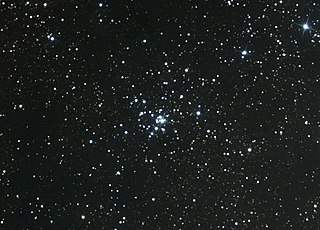
Messier 21 or M21, also designated NGC 6531 or Webb's Cross, is an open cluster of stars located to the north-east of Sagittarius in the night sky, close to the Messier objects M20 to M25. It was discovered and catalogued by Charles Messier on June 5, 1764. This cluster is relatively young and tightly packed. A few blue giant stars have been identified in the cluster, but Messier 21 is composed mainly of small dim stars. With a magnitude of 6.5, M21 is not visible to the naked eye; however, with the smallest binoculars it can be easily spotted on a dark night. The cluster is positioned near the Trifid nebula, but is not associated with that nebulosity. It forms part of the Sagittarius OB1 association.

Messier 26, also known as NGC 6694, is an open cluster of stars in the southern constellation of Scutum. It was discovered by Charles Messier in 1764. This 8th magnitude cluster is a challenge to find in ideal skies with typical binoculars, where it can be, with any modern minimum 3-inch (76 mm) aperture device. It is south-southwest of the open cluster Messier 11 and is 14′ across. About 25 stars are visible in a telescope with a 150–200 mm (6–8 in) aperture.

Messier 35 or M35, also known as NGC 2168, is a relatively close open cluster of stars in the west of Gemini, at about the declination of the sun when the latter is at June solstice. It was discovered by Philippe Loys de Chéseaux around 1745 and independently discovered by John Bevis before 1750. It is scattered over part of the sky almost the size of the full moon and is 2,970 light-years away. The compact open cluster NGC 2158 lies directly southwest of it.

Messier 39 or M39, also known as NGC 7092, is an open cluster of stars in the constellation of Cygnus, positioned two degrees to the south of the star Pi Cygni and around 9° east-northeast of Deneb. The cluster was discovered by Guillaume Le Gentil in 1749, then Charles Messier added it to his catalogue in 1764. When observed in a small telescope at low power the cluster shows around two dozen members but is best observed with binoculars. It has a total integrated magnitude (brightness) of 5.5 and spans an angular diameter of 29 arcminutes – about the size of the full Moon. It is centered about 1,010 light-years away.
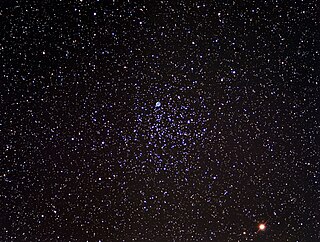
Messier 46 or M46, also known as NGC 2437, is an open cluster of stars in the slightly southern constellation of Puppis. It was discovered by Charles Messier in 1771. Dreyer described it as "very bright, very rich, very large." It is about 5,000 light-years away. There are an estimated 500 stars in the cluster with a combined mass of 453 M☉, and it is thought to be a mid-range estimate of 251.2 million years old.

Messier 50 or M 50, also known as NGC 2323, is an open cluster of stars in the constellation Monoceros. It was recorded by G. D. Cassini before 1711 and independently discovered by Charles Messier in 1772 while observing Biela's Comet. It is sometimes described as a 'heart-shaped' figure or a blunt arrowhead.

NGC 381 is an open cluster of stars in the northern constellation of Cassiopeia, located at a distance of approximately 3,120 light-years from the Sun. Credit for the discovery of this cluster was given to Caroline Herschel by her brother William in 1787, although she may never have actually seen it.

NGC 6791 is an open star cluster in the Lyra constellation. It was discovered by Friedrich August Theodor Winnecke in 1853. At roughly 8 billion years old, and with an iron to hydrogen abundance ratio that is more than twice that of the Sun, it is one of the oldest and most metal-rich clusters in the Milky Way. This is contrary to the typical rule-of-thumb where older means more metal-poor. Compounded with the fact that it has an unusually high population of stars, NGC 6791 is among the most studied clusters in the sky.

NGC 1502 is a young open cluster of approximately 60 stars in the constellation Camelopardalis, discovered by William Herschel on November 3, 1787. It has a visual magnitude of 6.0 and thus is dimly visible to the naked eye. This cluster is located at a distance of approximately 3,500 light years from the Sun, at the outer edge of the Cam OB1 association of co-moving stars, and is likely part of the Orion Arm. The asterism known as Kemble's Cascade appears to "flow" into NGC 1502, but this is just a chance alignment of stars.
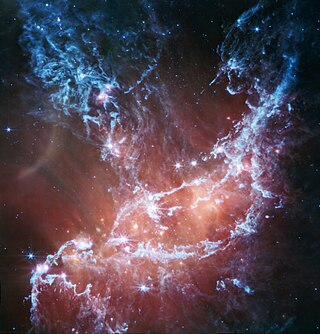
NGC 346 is a young open cluster of stars with associated nebula located in the Small Magellanic Cloud (SMC) that appears in the southern constellation of Tucana. It was discovered August 1, 1826 by Scottish astronomer James Dunlop. J. L. E. Dreyer described it as, "bright, large, very irregular figure, much brighter middle similar to double star, mottled but not resolved". On the outskirts of the cluster is the multiple star system HD 5980, one of the brightest stars in the SMC.

NGC 290 is an open cluster of stars in the southern constellation of Tucana. This cluster was discovered September 5, 1826, by Scottish astronomer James Dunlop. It lies some 200,000 light years away from the Sun in the Small Magellanic Cloud galaxy. The cluster is an estimated 30–63 million years old and is around 65 light years across.

NGC 6530 is a young open cluster of stars in the southern constellation of Sagittarius, located some 4,300 light years from the Sun. It exists within the H II region known as the Lagoon Nebula, or Messier 8, and spans an angular diameter of 14.0′. The nebulosity was first discovered by G. B. Hodierna prior to 1654, then re-discovered by J. Flamsteed circa 1680. It was P. Loys who classified it as a cluster in 1746, as he could only resolve stars. The following year, G. Le Gentil determined it was both a nebula and a cluster.
NGC 6738 is an astronomical feature that is catalogued as an NGC object. Although listed as an open cluster in some astronomical databases, it may be merely an asterism; a 2003 paper in the journal Astronomy and Astrophysics describes it as being an "apparent concentration of a few bright stars on patchy background absorption".

NGC 6208 is an open cluster in the southern constellation of Ara. With an age of 1.17 Gigayears, it is one of the oldest known open clusters.
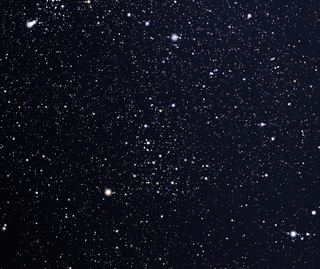
NGC 6200 is an open cluster in the constellation Ara, lying close to the galactic equator. It contains one β Cephei variable.
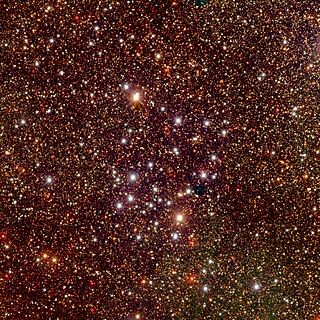
NGC 6281 is an open cluster of stars in the constellation Scorpius. It was not included in the Messier or Caldwell catalogues of nebulous objects, but it is the brightest such cluster in the constellation to be left out of both. It is readily observed with the naked eye; it is located about 2° to the east of Mu Scorpii. James Dunlop described the cluster as a "curiously curved line of pretty bright stars, with many stars mixt". John Herschel then described the cluster as both "pretty bright" and "pretty rich".

NGC 2439 is a sparse open cluster of stars in the constellation Puppis. It has an apparent visual magnitude of 6.9, an angular size of 10 arcminutes, and is visible using a small telescope. This is a young cluster with age estimates in the range of 20–300 million years. It has a tidal radius of approximately 82 light years. No chemically peculiar stars have been found.

NGC 6604 is a young open cluster of stars in the equatorial constellation of Serpens, positioned about 1.5° north of the Eagle Nebula. The cluster was discovered by William Herschel on July 15, 1784. It is located at a distance of 4,580 light years from the Sun, about 210 ly (65 pc) above the galactic plane. NGC 6604 forms the densest part of the Ser OB2 association of co-moving stars.

NGC 376 is a young open cluster of stars in the southern constellation of Tucana. It was discovered on September 2, 1826, by Scottish astronomer James Dunlop. Dreyer, a Danish/British astronomer, described it as a "globular cluster, bright, small, round." It is irregular in form, with a central spike.


















